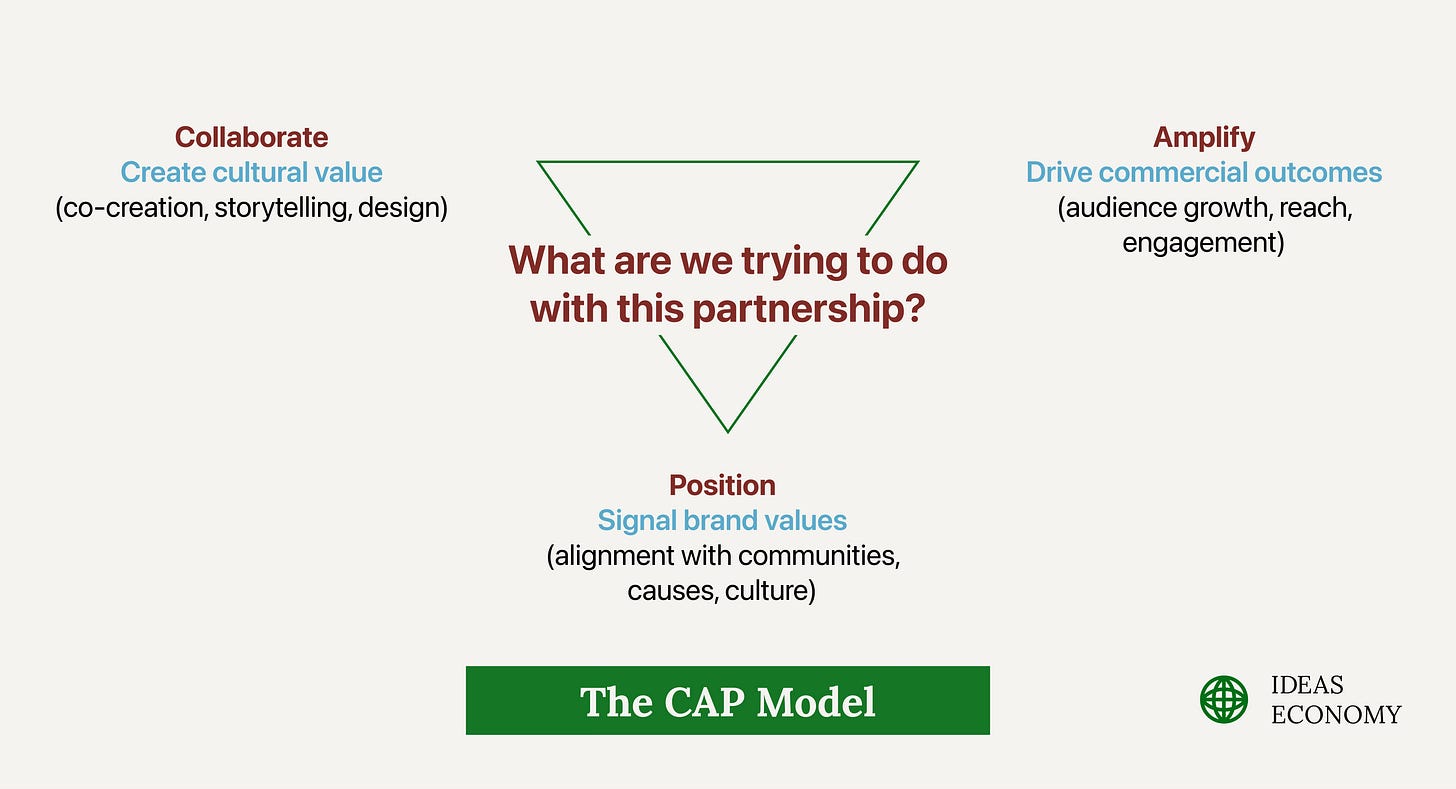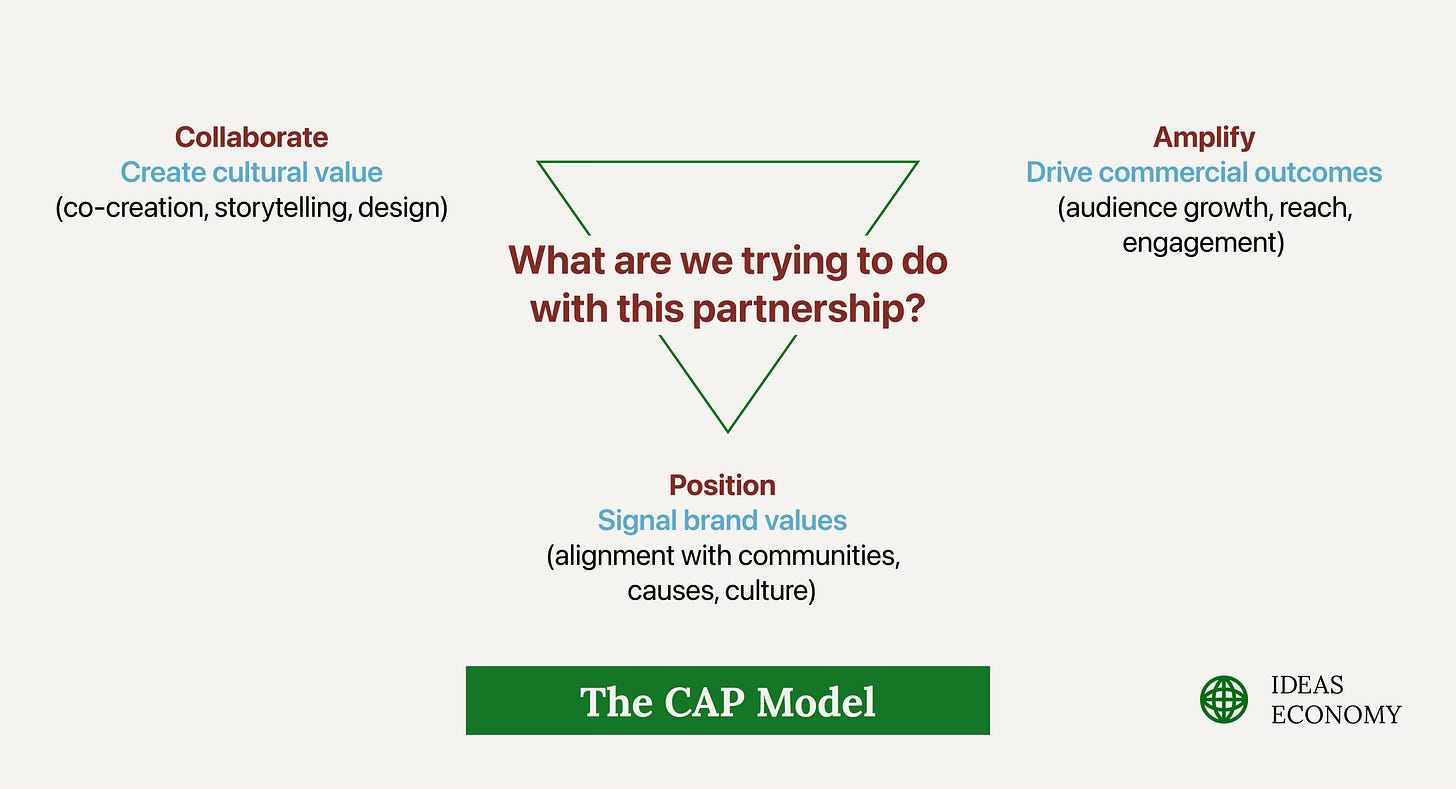The CAP Model
A framework for brand partnership strategy.
Brand and marketing partnerships take intangible value — cultural relevance, audience trust, emotional association, public reputation — and convert it into something tradable. A halftime show at a sports game doesn’t exist by default. Nor does a limited-edition collab or a sponsored event segment. They are first imagined, constructed, and then monetised. This is the capital of ideas in action.
For companies, marketing partnerships become a valuable strategic tool, where new value is inserted into existing experiences by converting context into a canvas for economic exchange. Good deals go beyond immediate sales. They align with belief systems, amplify mutual visibility, and sometimes, rewrite market positioning, and thus set up both parties for sustained growth and market presence.
In practice, a lot can go wrong or, at best, get messy after a deal is secured. In my experience, the easiest way to manage sponsorships is to have a clean way of distinguishing why you are partnering with another brand or company.
Why is it important to distinguish between the intent of sponsorships?
For the sponsor, you need to know how exactly each deal contributes to your strategic priorities.
For the sponsee, you need to know what you are selling to the sponsor.
For both, this is going to help you be more intentional about who you collaborate with.
Really simple, but so easily overlooked. So, here is your Mental Model to help you be a better partnerships strategist:
This month’s Mental Model: The CAP Model
Key idea: Not all brand partnerships serve the same purpose. The CAP Model helps you quickly categorise them through three strategic lenses, so your execution matches your intent.
Use it to: Clarify the purpose of a sponsorship or partnership and guide your approach, creative strategy, and success metrics.
Core components:
C – COLLABORATE
Objective: Co-create distinct products, experiences, or stories that blend brand identities.
Strategic leverage: Cultural capital, originality, and earned media attention.
Use when: You want to differentiate, capture cultural relevance, or generate creative buzz.
Common formats: Capsule collections and product drops; joint storytelling in films, podcasts, editorials; UX or design; limited edition packaging or formats.
A – AMPLIFY
Objective: Leverage another brand’s audience, reach, or engagement channels.
Strategic leverage: Distribution scale, audience engagement, and conversion opportunities.
Use when: Your goal is to boost awareness, acquire new customers, or drive performance metrics.
Common formats: Co-marketing campaigns and cross-promotions; platform takeovers and content syndication; media partnerships or branded content series; loyalty and referral program integrations.
P – POSITION
Objective: Align with values, communities, or cultural movements to build relevance.
Strategic leverage: Brand trust, market resonance, and long-term equity.
Use when: You need to shift perception, deepen loyalty, or signal authentic cultural alignment.
Common formats: Event partnerships, pop-ups, festivals; cause-based or ESG-aligned campaigns; collaborations with artists, creators, or subcultures; sponsorship of cultural institutions or movements.
Examples and why they work:
C – COLLABORATE
Objective: Co-create distinct products, experiences, or stories that blend brand identities.
Balmain X Barbie
Limited edition fashion collection and NFT drop combining Balmain’s haute couture and Barbie’s iconography, sparking cultural buzz and exclusivity-driven demand.Supreme X Louis Vuitton
Two iconic brands co-creating a limited edition collection, fusing streetwear and luxury. Sparks massive cultural buzz by blending identities and creating new cultural capital.IKEA X Virgil Abloh
Functional home items turned into art objects. Made homewares part of the design and streetwear conversation. Limited runs drove collector urgency.
A – AMPLIFY
Objective: Leverage another brand’s audience, reach, or engagement channels.
Spotify X Starbucks
Starbucks integrates Spotify playlists instore, while giving baristas Spotify Premium, combining music discovery with café ambience. This is co-marketing that taps into Spotify’s content and Starbucks’ foot traffic.Netflix X Lacoste
Lacoste reimagines their classic polos with design elements from Netflix shows (Stranger Things, The Witcher, Bridgerton) and runs cross-promotional campaigns. Fashion meets fandom through a media-fashion synergy.Qantas X Wallabies
Qantas airlines was the naming rights sponsor of the Australian national rugby team for two decades. Massive association with national pride and the emotional amplification of that. A seamless brand crossover that links travel with sports. Additional long-term brand association with values like grit, teamwork, and national identity. Slightly a POSITION angle but dominantly this partnership is to AMPLIFY.Red Bull X F1
In fact, Red Bull owns the racing team, giving full control of the audience narrative and content. Huge YouTube and Netflix presence via Drive to Survive. Uses F1 as a platform for Red Bull’s identity as an energy-fuelled, high-performance brand. Extreme audience amplification and brand embodiment.
P – POSITION
Objective: Align with values, communities, or cultural movements to build relevance.
Adobe X Sundance Film Festival
Supporting emerging filmmakers through funding, software, and storytelling labs. Adobe aligns with a creator community central to its brand, while reinforcing its positioning as an enabler of creative independence.The Metropolitan Opera X Tiffany & Co.
Tiffany sponsors Met Opera productions and offers limited-edition jewellery collections inspired by operatic themes. Clear cultural alignment linking luxury and heritage art forms.The Louvre X Adidas
Produced exclusive sneaker drops inspired by art collections, blending fine art and street culture, and roots in cultural resonance.Tate Modern X BMW
BMW sponsors exhibitions and commissions, supporting the museum’s contemporary art mission while subtly positioning itself as a patron of innovation and culture.
You can learn about how I help brands and institutions shape their commercial partnerships strategies via my consultancy work: https://rachelobrien.work/partnerships.




